#gall wasps
Text
“Its like how I’ve heard your kind describe the galls you get in your teeth—“
“do you mean cavities!?”
“Just so! It is like how when examined by the tongue the cavity is said to seem very large. But in reality it is small. That is how it is with mine ovipositor. I can see the cell walls the holy scriptures in the language of the enzymes… and I just reach in and then? I make little correction. I make little change. That is how I make the gall.”
I still didn’t feel like I understood. But still I had to set the wasp right on one troublesome matter.
“Madam Wasp? The cavities we get in our teeth are not galls. OK?”
“oh. what a pity. Teeth seem like such a nice safe place to put your child—“
“I promise you they are not at all suited to your needs.”
“oh. oh well then.” she huffed.
I was confident the notion had abandoned her. But still kept my mouth tightly closed.
128 notes
·
View notes
Text

big day for the bell pepper fandom. gall wasps are very common and diverse around here but this one (Andricus grossulariae) makes the weirdest galls by far. always wanted to see one of these and finally got lucky
if you're at all familiar with gall wasps, this is probably as cool to you as it is to me. if you're not familiar with gall wasps, i urge you to take some time to learn about them and be amazed at the fact that there are little animals that give plants avant-garde looking acne and then live inside it. either way tl;dr there's men in there
78 notes
·
View notes
Text

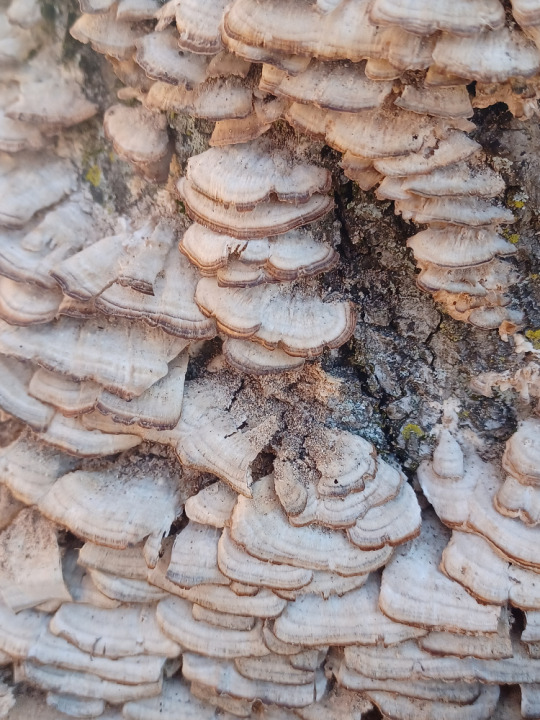
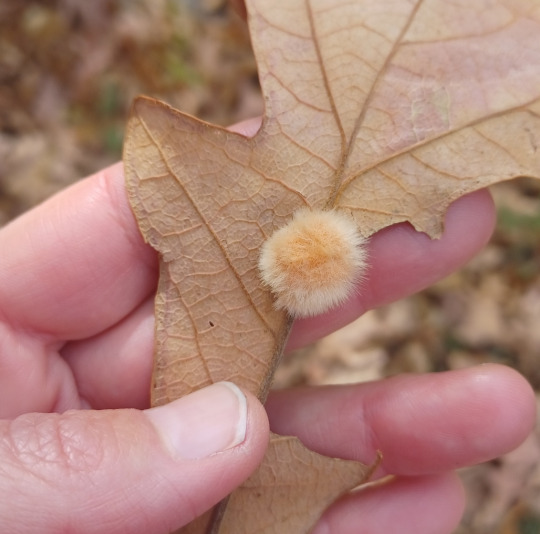
Well, it's been a whirlwind few days! Thursday I went on the weekly phenology walk at Audubon Trails Nature Center in Rolla, MO. It's the last one of the year, and we were seeing if there were still any wildflowers in bloom in spite of the freeze a few nights before. We did find a scant few Asteraceae with open flowers, but for the most part everything was done for the year. It was a really good experience getting to wander the trails with someone who knows the local flora really well; I'm still playing catch-up on learning (and remembering) native prairie plants in this area, and since they happen every Thursday morning during the growing season, I'm going to make sure and attend whenever I'm in town.
Thursday afternoon I officially taught my first in-person class in Rolla with my basic mushroom foraging intro at the Rolla Public Library. I checked out SO MANY BOOKS from that library as a kid, and so it was basically coming full circle to be able to teach there. I had an awesome audience that packed the room, got some great questions, and really appreciated the support that library staff gave me throughout the entire process. I'm already brainstorming what I want to teach when I head back to this area next spring.
Friday I got to spend immersed in planty goodness at the Missouri Botanical Symposium. I had actually registered last year but ended up not feeling good at the last moment so I had to miss out. Totally worth the entire trip this year, though! There were some really great talks (I especially enjoyed the one on the interplay of geology and plant life in Missouri karst fens), and I even made some good connections and new friends! I am SUCH an introvert that it can be tough for me to go around introducing myself in a room where I don't know anyone, but luckily a friendly extrovert latched onto me and helped me meet some really cool people. (Also, pro tip: having art supplies out and in use makes for a great conversation starter, and if you bring enough for others to use you can have a little science illustration party at your table!)
Saturday I peeled myself out of bed early yet again for a very good reason--I got to lead a lichen hike at Audubon Trails! It sort of felt like cramming for a test because while the basic biology of lichens is the same everywhere, I'm not as familiar with local species here as I am back home in the PNW. So I visited the site a few times on this visit to look for cool lichens and try to get them down to at least a genus level, if not species. Again, really great turnout for the hike--people were having a great time, lots of excellent questions and discoveries along the way. And there were two kids from the Rolla Outdoor Collaborative School on site who were not only THE best guides to the trails there, but they found and showed off some cool stuff (including lichens, AND fuzzy oak galls!) The next generation of naturalists is already well on their way to helping others connect with the great outdoors, which does my heart good.
I gotta start driving back west tomorrow; I have classes in Portland next weekend. So today is being lazy, doing laundry, and helping my folks with a few more things around the house. It's been another great visit here, though, and I'm already making plans for next year. I'm going to try to schedule a couple of classes along the way for my spring trip; since I'll likely be taking I-70 since 80 is sketchy even in April, I'm probably looking at Salt Lake City and Denver for venues. I'm open to suggestions if anyone knows of a bookstore, library, nature center, or similar who might like to host a wandering naturalist infodumping about ecology for a couple of hours!
#Missouri#Ozarks#nature#naturalist#mushrooms#fungi#mushroom hunting#prairie#tallgrass prairie#oak gall#gall wasps#oak#oak trees#ecology#plants#botany
19 notes
·
View notes
Text

A Textbook in General Zoology. Written by Henry R. Linville, Henry A. Kelly, Harley J. Van Cleave. 1929.
Internet Archive
45 notes
·
View notes
Photo
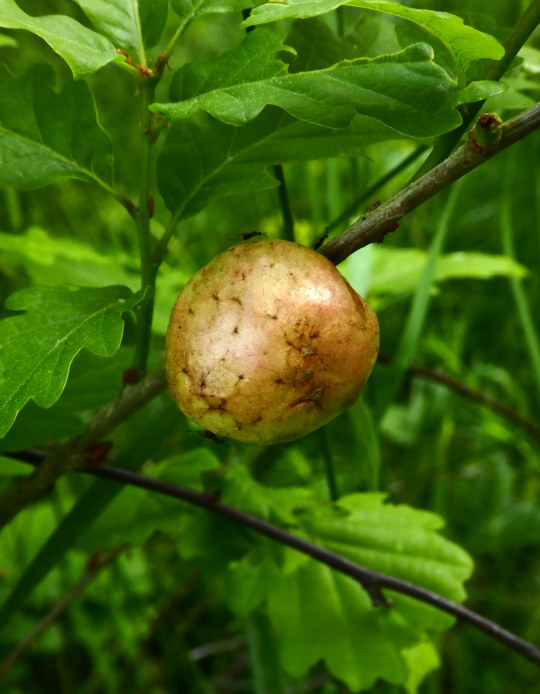
nějaké žlabatky..
-L.F.
6 notes
·
View notes
Text
this is the most disappointing picture I've ever taken
A wasp was sitting on the acorn drinking out of the cap not even a second before I took this picture. It flew away completely before my thumb hit the camera button. RIP.
but anyways look at that wasp gall next to the cap, it's the little brown sphere on the bottom of the leaf, probably the species Belonocnema treatae, which doesn't have a common name.
This is a southern live oak tree, which is evergreen! It's weird. The acorns when ripe are a very shiny black, with a noticeable "tan line" where the cap was, which stays pale tan. It's a host plant for multiple species of gall wasps, including Belonocnema treatae, but also:
Callirhytis quercusbatatoides, aptly named the Southern Live Oak Stem Gall Wasp, because it forms galls on the stem rather than the leaves.
There's also Andricus quercusfoliatus, the Leafy Oak Gall Wasp, which also forms galls on the stems, but they almost look like fluffy acorn caps, and the first few times I saw them, I thought they /were/ developing acorns!

[ID: A portrait photograph of a southern live oak tree, with an empty acorn cap facing the camera that has a few drops of water in it. Below and around it are unripe acorns still in their caps, which are dark green on the ends and paler green towards the cap.
The leaves of the live oak are dark green, and shaped long long ovals, with slightly wavy edges. The stems are light tan, with clusters of red pointed buds at the end of each twigs. Some spanish moss, with strands of fuzzy light grey, curl around the twigs and a dead branch.
Next to the acorn cap in the center of the photo, on a leaf behind it, is small, red-brown sphere of a wasp gall from the species Belonocnema treatae.
Some sparce grass and dead leaves are visible on the ground in the background
End ID.]
#Rjalker takes pictures#southern live oak#quercus virginiana#live oak#live oaks#oaks#acorns#spanish moss#wasp galls#gall wasps#?#Belonocnema treatae#galls#oak galls
3 notes
·
View notes
Text

Don’t think i ever posted my show logo on here mostly because I usually forget it exists but I think it looks quite nice to be honest. named my show inspired by the research of Alfred Kinsey prior to the sex stuff
0 notes
Text
Parts of the world got to experience the excitement of a solar eclipse this afternoon, and later on I was treated to a tiny partial lunar eclipse. The little green moon, Amphibolips quercusracemaria oak gall, and a tiny hyperparasitoid wasp!

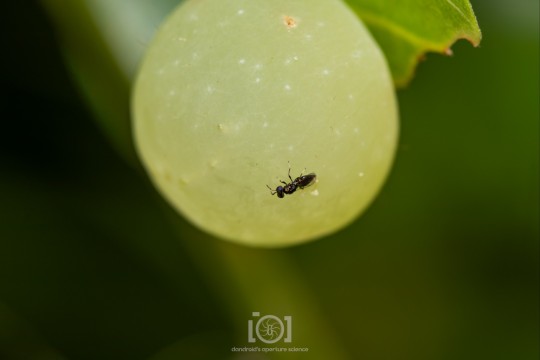

358 notes
·
View notes
Text

Mushroom gall wasp larvae make these adorable little houses! Photo by Timothy Boomer.
1K notes
·
View notes
Text
@fluffydogsquad submitted: Flipped over a big stick in my yard and found a bunch of friends. Any idea who the winged friend could be? Also the pal with the long black-and-orange segmented body. Found in New Jersey.
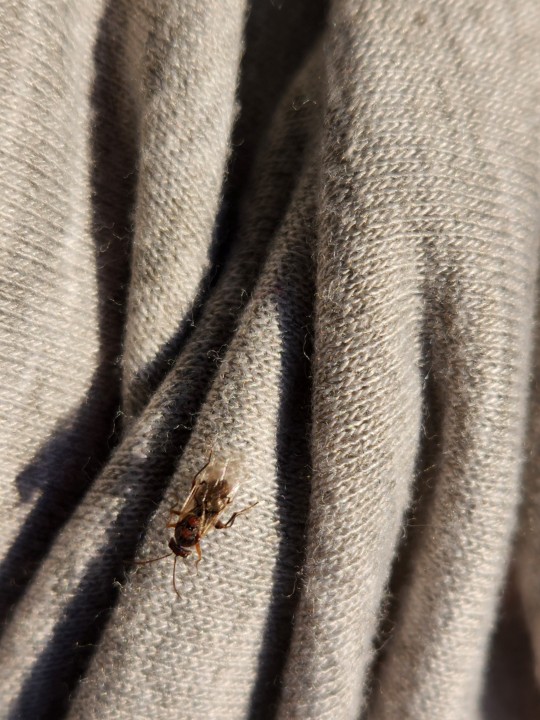

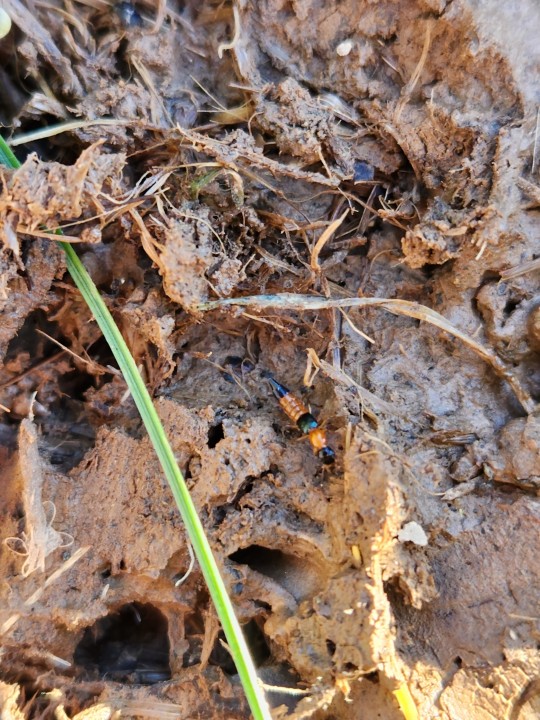

Looks like a gall wasp, I think. Couldn't say which species. The second dude is a rove beetle, maybe Paederus littorarius or similar. The last one is a click beetle, probably a sweet click beetle, Aeolus mellillus. Great group of pals! Always fun to see what's under a rock or stick.
#animals#insects#bugs#submission#wasp#gall wasp#beetle#rove beetle#click beetle#sweet click beetle#Paederus littorarius
63 notes
·
View notes
Text
The Glorious Complexity and Mysteries of Galls, Wasps, Ants, and Aphids
Plant galls are structures of plant tissue that grow in response to the actions of arthropods, bacteria or fungi. These living things hijack the plant and "make" it grow something they find useful.

An "oak apple" type gall created by a parasitic wasp by laying an egg in the leaf as it was growing.
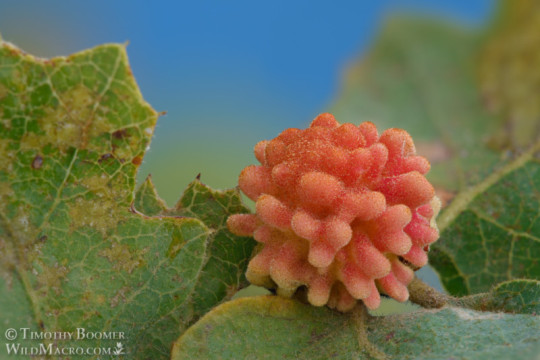
The shapes and structures of galls vary wildly, and often have no obvious correspondence to any of the other parts of the plant. (If you you have a strong trypophobia response be careful googling images of galls some make my crawl, others are etherial)

Some galls seem to be optimized to foil parasitoids who try to lay their eggs inside the pupae of other insects. A wasp would need a very long ovipositor to get to this larva suspended in the center! Somehow the wasp egg induces the tree to grow this complex structure! Amazing!

Although ants are closely related to wasps who play a large roll in the formation of plant galls, ants are *normally* only secondary fauna of galls and not gallmakers.

This is surprising to me since so many plants roll out a welcome mat for ants: extrafloral nectaries as cafeterias, hollow stems& thorns as dormitories. A resident colony of ants can be a plants personal private security detail.
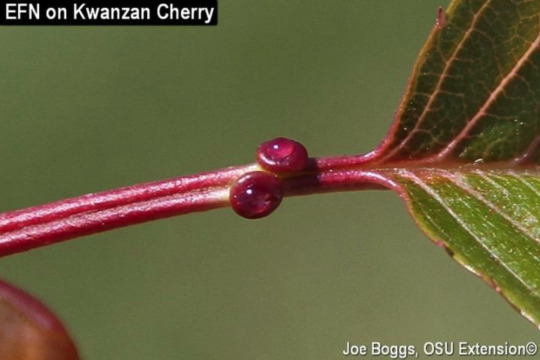

For all the many symbiotic parings of ants and plants there are only a few ants that induce their own galls. As secondary fauna of galls (often created by their creepy cousins, the parasitoid wasps) ants may also act as pest control.
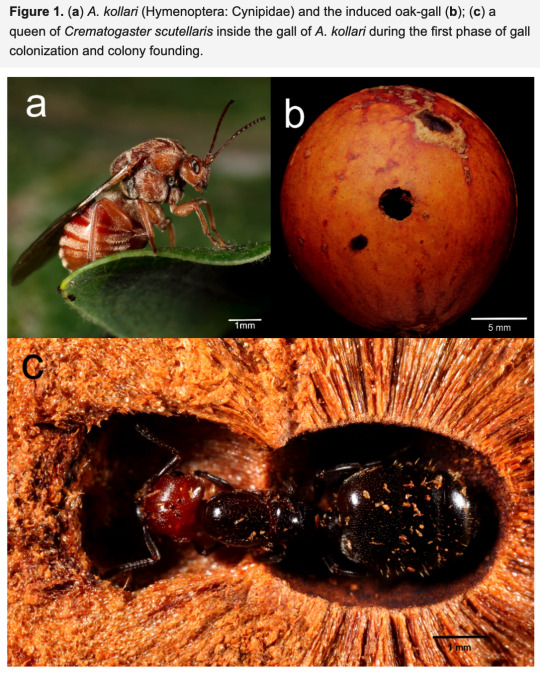
This raises the question: Could plants "allow" gall wasps to make these otherwise energy intensive and potentially harmful structures in hopes of attracting ants as secondary guests? It's a complex web of ecological relationships! Read more here.
Another potential player in this story of galls and wasps and ants are aphids. Aphids are the other main insect that can induce galls. The aphids live in these galls for generations (they don't live long so this is only several months) Of course, ants are famous farmers of aphids.
(Some gallmaking wasps get attacked by hyper parasitoid wasps who only lay their eggs in other gall wasps galls. To prevent this some gallmakers make the galls attractive to ants... who can deter the invaders.)
Glorious Complexity!
#plant gall#plant galls#galls#oak apple#oak apples#wasps#hymenoptera#insects#damn nature you scary#ants#ant#antposting#aphids#ecology#biology#trees#parasitic#parasitoid#parasitology#symbiotic
565 notes
·
View notes
Text

have you ever seen a gall with a toupee? these were made by Trichilogaster acaciaelongifoliae, a gall wasp that parasitizes wattles (specifically long-leaved wattles) and, as i later found out, is being used as a biological control agent in portugal against these invasive plants. galls don't generally damage plants, but apparently these have been found to reduce seed production, so i hope it helps because these things are everywhere. this was the only tree (out of dozens) with any galls, but it had a bunch on it. i wonder why the wasps all chose this one specifically

here's another (blurry, they were pretty high up) photo that really shows how the flowers are growing on them. i have no idea how this works but i'm told nobody has any idea how anything works as far as galls are concerned, so that's okay
1 note
·
View note
Text
Okay, so this is really cool! You have this phenomenon where some plants grow edible appendages to their seeds to entice ants to carry them underground where they can safely sprout. And then you have wasps which lay their eggs on the leaves, stems, and other parts of plants and trigger the growth of galls (swellings) which both feed and protect the wasp larvae until they reach maturity.
The boy who was watching the ants noticed they were taking wasp galls underground, too. Further exploration found that the wasp larvae were unharmed inside the galls; the only thing the ants had eaten were edible appendages similar to those on the seeds they collected. The wasp larvae stayed safe inside the ant nest, feeding on their galls, until it was time to emerge and head back out to the surface.
So it turns out that the edible portions of the galls have the same sorts of fatty acids as the edible parts of the seeds. And those fatty acids are also found in dead insects. Scientists think that the wasps evolved a way to make the galls they created mimic the edible portions of the seeds to get the ants to collect the galls. This isn't the only example of wasps making use of ants as caretakers for their young, but it's a really fascinating example thereof--especially if you consider ants evolved from wasps at least 100 million years ago.
#wasps#ants#plants#galls#oak galls#insects#invertebrates#Hymenoptera#ecology#bugs#animals#wildlife#nature#trees#entomology#science#natural science#evolution#animal behavior
12K notes
·
View notes
Text
Interesting new discovery!!
Oak wasps lay eggs on oak tree leaves. This stimulates the oak tree to form a gall around the egg. The gall eventually falls off (with the eggs inside) and are harvested by ants. These ants harvest galls because gall caps contain nutritious fatty acids. The ants bring galls back to their nest, take up the gall caps, and leave the remainder of the gall in their nest, thus protecting the egg from predators.
72 notes
·
View notes
Text


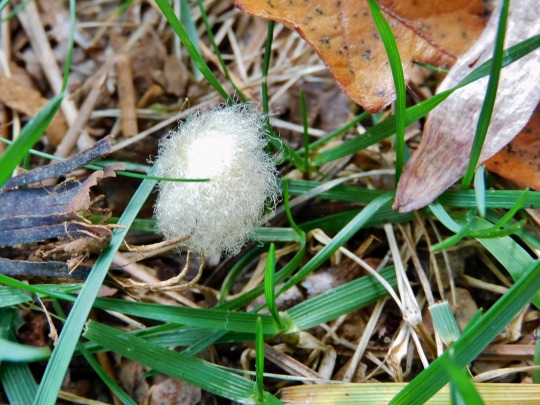
Some Detachable Woolly Leaf Galls from a gall wasp (Andricus quercuslanigera)...
#nature#my photography#backyard nature#wasp gall#insect eggs#galls#nature photography#wasps#wildlife photography
20 notes
·
View notes
Text



Goretober: Crystals, Bugs, & Parasite
#goretober#crisisgoretober2023#oc-tober#traditional art#original art#image id in alt text#lonely dog draws#blood#gore#trypophobia#nudity#veins#oc tag#oc (leif)#oc (avalon)#think i may need a tag for bird-leech-person#oc (mercredi)#<- ?#leech lady is the only one here having a great time. she is so full of yummy blood ^_^#avalon is based on wasp galls‚ but i dont really know what the wasps do so i just included generic grubby things#these kind of gross me out & i'm the one who drew them so i'm gonna put a community label on this
21 notes
·
View notes